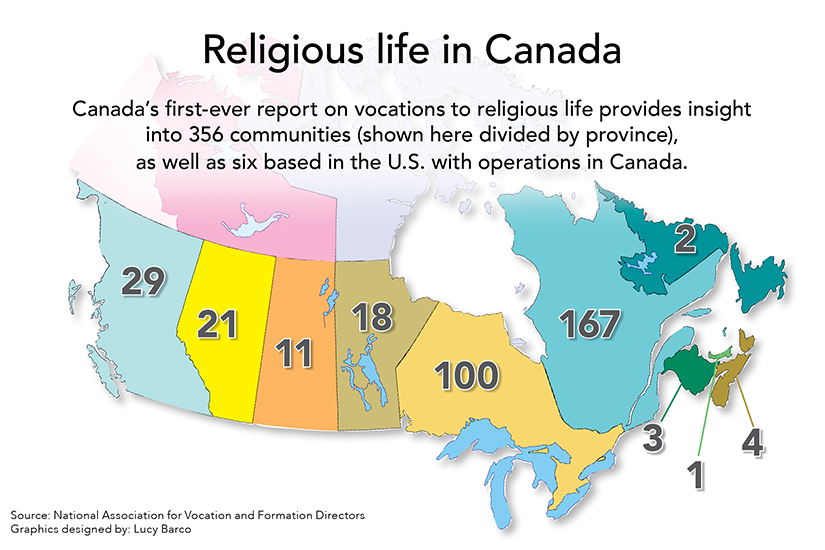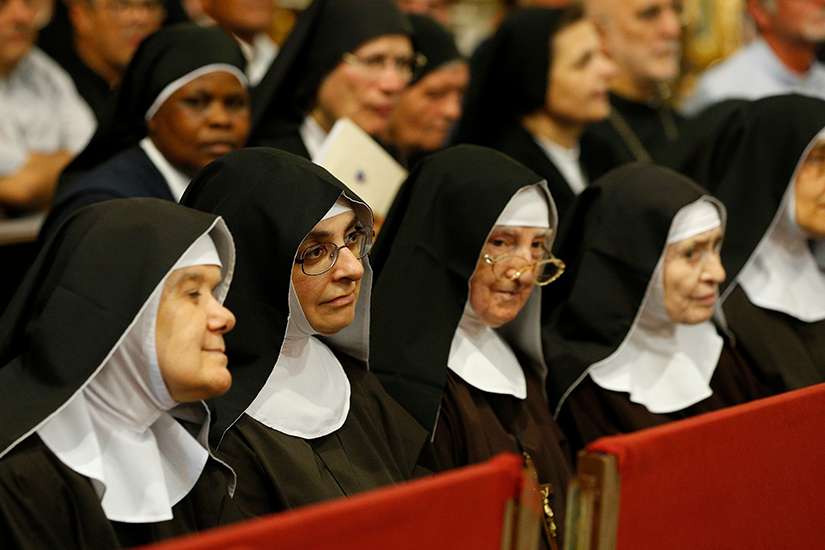Why? A new report suggest two possible factors: the order’s dynamic website and its retention of a traditional habit.
The impact of new world technology and old world customs is just one area explored in a report that, for the first time in Canada, offers insight into the men and women who are entering religious life and religious institutes.
The research study, “Recent Vocations to Religious Life in Canada,” released Sept. 28, was conducted by the National Association for Vocation and Formation Directors (NAVFD) in Canada.
“This, for us, is like a lovely springboard so that we can dive into the future,” said Sr. Mary Rowell, NAVFD president and member of the Congregation of Sisters of St. Joseph in Canada. “And now, we’re committed to capturing that foundation and building up.”
Vocation animation in the digital spaces is a priority for today’s religious institutes. Men and women religious orders have identified their websites as the main medium in which to communicate their mission (60 per cent for men, 48 per cent for women). Print materials remain important tools (43 per cent for men, 41 per cent women) and social media is the third popular medium (43 per cent for men, 21 per cent for women).

Sr. Carol Forhan, vocations director for the Sisters of Adorers, said their website has been a great resource for young women who have sought discernment with them. Before 2008, few women had come to the monastery in London, Ont., but since then the community has received 13 new members.
“Our website, we realize, is probably the most helpful vehicle through which young people are getting to know about our community,” said Forhan in an e-mail.
Still, online presence is not enough to attract vocations. Forhan said the website brings young women to their door, but the personal encounter with their new members is what helps them initiate the discernment process.
“Each new member also has individual times of direction with the formation director, as well as having a spiritual director, as she discerns her own vocation during these important years,” she said.
New members are defined in the survey as those who are in initial formation and up to those in final/perpetual vows since 2000.
According to the study, 88 per cent of new members surveyed said meeting with members of the institute, spiritual direction (88 per cent) and attending retreats (77 per cent) were most helpful in discerning their call to religious life.
About half (51 per cent) found websites and other digital sources “somewhat” or “very” important. Diocesan websites, print materials and diocesan programs were identified as some of the least helpful resources for discerning religious.
While exposure to religious life is identified as a key factor when discerning, about half of religious orders that responded to the survey (55 per cent) require its members to wear a habit for all or most circumstances. About 23 per cent say habits are optional and 18 per cent require members to wear a habit only at certain times.
The report showed that habit-wearing communities are 19 per cent more likely to have new members.
Research lead Héctor Acero Ferrer said respondents agreed that community life is the most important attraction to religious life. Having companions in prayer and in daily living are priorities for new members.
“It’s difficult to see it in the survey ... but in the context of the focus group discussions and the site visits, you can see that they arrive at the same conclusion,” said Ferrer. “Also in the more traditional orders and the more progressive orders, new members from both extremes felt the same about community life.”
Vocations are becoming much more diverse as Canadian immigrants become a more integral part of Church life. About 30 per cent of new members surveyed were born outside of Canada. Asia and Oceania are the biggest immigrant group with seven per cent of new members. About six per cent originated from Europe and five per cent from Africa.
The average age of all new members is 44 years old. With 61 per cent of all religious being 78 years old and older, the younger religious members are feeling the strain of the growing age gap. Only 12 per cent, including those in formation, are 57 or younger. They are usually tasked with administration and taking care of their elder members.
Many of the younger members find it difficult to relate to their elder members and often find themselves alone in experiencing the “initial zeal of religious life while the rest of the institute is in a period of contraction” from active ministry, according to an unidentified respondent quoted in the study.
During focus group discussions and site visits, Ferrer said there is an emerging desire for younger religious to live and work with members of other orders.
“It came up a number of times, in contexts like, ‘Our own numbers are declining and we get a lot of life when we go out and have a retreat with other religious.’ Or, ‘We go to a church event and we meet other religious and interact with them,’ ” said Ferrer. “They started kind of dreaming up what projects they could work on together.”
For a long time, Rowell said Canadian directors referred to a similar study conducted by the Center for Applied Research in the Apostolate in the United States in 2009. They would also look to similar CARA studies conducted in Australia and France.
Overall, Rowell said the experience of religious life in all these countries has been consistent with what vocations and formation directors are seeing in Canada.
The full report can be found on vocations.ca.


